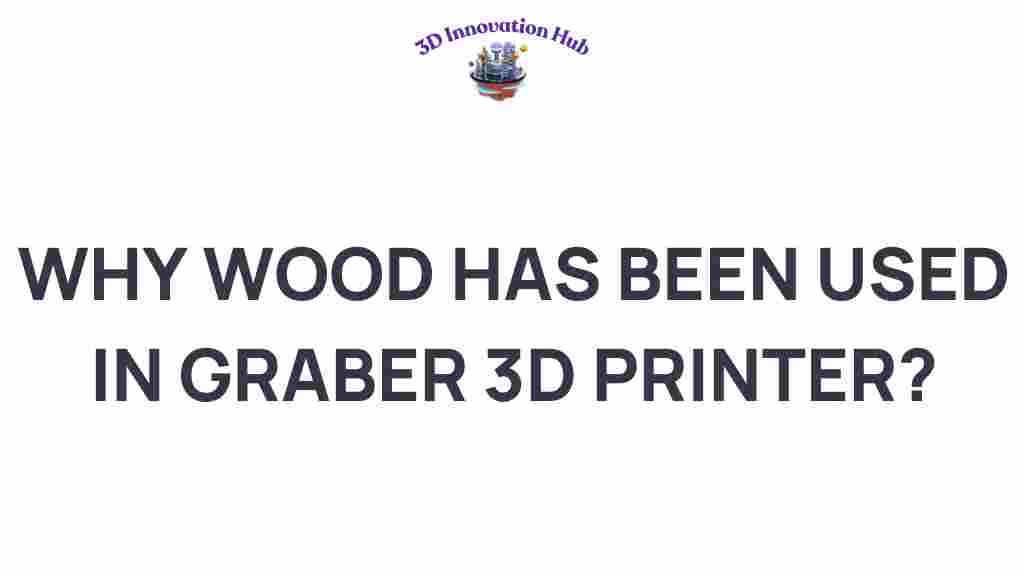Unveiling the Secrets: Why Wood is the Material of Choice in Graber 3D Printers
In the rapidly evolving world of additive manufacturing, the materials used in 3D printing play a vital role in defining the quality and sustainability of the final products. One material that has gained considerable attention in recent years is wood. Among the leading 3D printing technologies, Graber 3D printers stand out, particularly when it comes to utilizing wood in innovative ways. This article will explore the reasons why wood is becoming the material of choice in Graber 3D printers, focusing on its ecological benefits, design versatility, and various 3D printing applications.
The Advantages of Using Wood in Graber 3D Printers
Wood, as a natural and sustainable material, offers numerous advantages that make it an ideal option for 3D printing. Here are some key reasons:
- Sustainability: Wood is a renewable resource, especially when sourced from responsibly managed forests. Using wood in 3D printing reduces the carbon footprint associated with traditional manufacturing processes.
- Eco-Friendly Printing: By utilizing wood filaments, Graber 3D printers enable eco-friendly printing options that appeal to environmentally conscious consumers.
- Design Versatility: Wood filaments can be mixed with other materials to create unique textures and finishes, allowing for a wide range of design possibilities.
- Technology Innovation: Graber 3D printers are at the forefront of technology innovation, effectively integrating wood into their printing processes.
- 3D Printing Applications: Wood is suitable for various applications, including prototyping, artistic projects, and even functional components.
Understanding Wood Filaments
Wood filaments are composite materials that combine traditional plastic filaments with wood particles. This innovative approach allows for the creation of 3D printed objects that possess the aesthetic and tactile qualities of wood while maintaining the benefits of plastic. Graber 3D printers have optimized their technology to work seamlessly with these wood filaments, providing users with high-quality prints.
Step-by-Step Process of 3D Printing with Wood in Graber 3D Printers
Using a Graber 3D printer to print with wood involves a straightforward process. Here’s a step-by-step guide to help you get started:
- Choose Your Wood Filament: Select a high-quality wood filament compatible with your Graber 3D printer. Popular options include PLA wood filaments, which combine polylactic acid with wood particles.
- Prepare Your Design: Use 3D modeling software to create or modify your design. Ensure that your model is suitable for the properties of wood, considering aspects like infill and layer height.
- Set Up Your Printer: Load the wood filament into your Graber printer. Adjust the temperature settings according to the filament specifications, typically between 180°C and 220°C.
- Print Settings: Optimize print settings for wood, such as slower print speeds to enhance accuracy and minimize stringing.
- Start Printing: Begin the printing process and monitor the print for any issues.
- Post-Processing: Once the print is completed, you may choose to sand or finish the surface to enhance its appearance and texture.
Troubleshooting Tips for 3D Printing with Wood
While printing with wood filaments can yield stunning results, you may encounter some challenges. Here are common issues and their solutions:
- Clogged Nozzle: If you experience a clogged nozzle, try reducing the print temperature or cleaning the nozzle thoroughly. Regular maintenance of your printer can prevent this issue.
- Inconsistent Extrusion: To avoid inconsistent extrusion, ensure that the filament is dry and free from moisture. Wood filaments can absorb humidity, which affects print quality.
- Warping: If warping occurs, consider using a heated bed or adhering your prints to the build surface with glue or tape to improve adhesion.
- Surface Finish: If you’re not satisfied with the surface finish, experiment with different sanding techniques and post-processing methods to achieve the desired effect.
3D Printing Applications with Wood
Wood filaments open up a world of possibilities in 3D printing applications. Here are some notable uses:
- Prototyping: Designers and engineers can create realistic prototypes that mimic the look and feel of wooden products.
- Artistic Creations: Artists can leverage wood 3D printing to create intricate sculptures and art pieces that showcase their creativity.
- Functional Components: Wood can be used in the production of functional parts, such as custom furniture or decorative items.
- Educational Tools: Wood 3D printing can be used to create educational tools and models for teaching purposes, particularly in design and architecture.
The Future of Wood in Additive Manufacturing
As technology innovation continues to advance, the future of wood in additive manufacturing looks promising. Graber 3D printers are leading the way in integrating sustainable materials like wood into their offerings. With the growing demand for eco-friendly printing solutions, we can expect to see further developments in wood filament technology, enhancing its properties and expanding its applications.
Moreover, the trend towards sustainability will drive more manufacturers to explore wood and other natural materials, aligning with the global movement towards greener practices. As consumers become increasingly aware of their choices, the demand for eco-friendly and sustainable printing options will continue to rise.
Conclusion
Wood has emerged as a preferred material in the world of Graber 3D printers, thanks to its sustainability, design versatility, and the exciting applications it offers. With the ability to create stunning, eco-friendly prints, wood is leading the way in additive manufacturing innovation.
As technology continues to evolve, embracing wood as a primary material in 3D printing aligns with the growing emphasis on sustainable materials and eco-friendly practices. Whether you are an artist, engineer, or hobbyist, exploring the capabilities of wood in 3D printing can open up a new realm of creative possibilities.
To learn more about Graber 3D printers and the innovative technologies they offer, visit Graber 3D Printers. For additional insights about sustainable materials and their impact on manufacturing, check out this resource.
This article is in the category and created by 3D Innovation Hub Team
